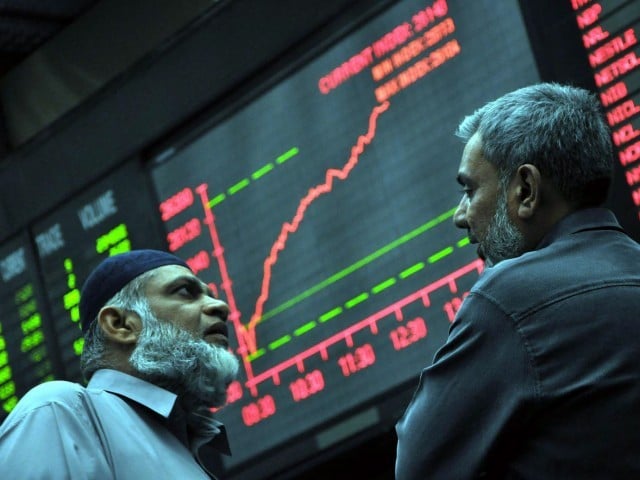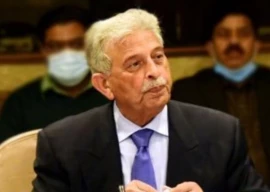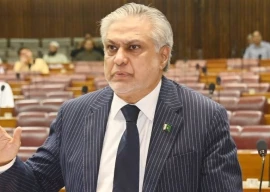
A relaxed monetary policy is assumed on the basis of a tightly-managed exchange rate regime with a moderate inflation of 6 % and low international crude oil prices. By taking these assumptions, policymakers expect a stable interest rate environment which may push the growth target beyond 5 %.
This year’s budget is the second after the approval of the Extended Fund Facility, which was meant to reduce fiscal deficit by increasing taxation and controlling expenditure to restore macroeconomic stability.
It shifted the focus of the government to savings by belt tightening. In the preceding two years, the government reduced the fiscal deficit from 8 % to 5.1 % of GDP by increasing non-tax revenues and capital receipts, reducing development expenditure, imposing provincial surpluses and piling up circular debt. Fortuitously, the sudden drop in the international crude oil prices helped in reducing current account deficit and taming inflation.
The shortfall in tax revenue has been covered through non-tax revenue such as SBP profit, dividends, defense receipts, foreign grants and mark-up on Public Sector Enterprises. However, the focus was on achieving quantifiable targets at the expense of quality objectives.
Managing debt servicing costs
The biggest challenge for the successive regimes is to prudently manage the domestic and foreign debt servicing costs. The sum total of domestic and foreign debt servicing is around Rs1.6 trillion which becomes 46 % of the current expenditure, while defence expenditure is around 23 % of the current expenditure.
Keeping in view the strategic, geographical and domestic exigencies, it is not easy to reduce the defence budget. Moreover, defense expenditure also creates positive externalities for the economy. The reduction in debt stock requires fair and progressive tax policy and governance reforms.
However, the budget falls short of these long standing structural objectives, leaving little space for subsidies.
The government budged Rs203 billion for subsidies and revised this up to Rs243 billion in FY 2014-15. Out of this amount, tariff differential subsidy was Rs221 billion ie Rs185 billion for Wapda, and Rs36 billion for K-Electric. The subsidy went up owing to less recovery of electricity dues by the Discos.
In addition, since this subsidy reduction entails high political cost, the government tries to appease hostile domestic agitators. Interestingly, the government budged Rs138 billion in FY 2015-16 for subsidies which are quite underestimated.
In the current budget, fiscal discipline will be imposed on the provinces through a top down mechanism, and the net expected provincial surplus is estimated at Rs297 billion for FY2015-16. Punjab is the forerunner to produce huge fiscal surplus of above Rs300 billion to reach this quantifiable goal.
In FY 2014-15, federal government budgeted 43 % of the gross revenue for the provinces and disbursed 39.8 % to the provinces as per the revised estimates. The ratio is decreased to achieve quantifiable fiscal deficit.
If the revenue target is not achieved in FY2015-16, Punjab and Balochistan would be affected the most since these provinces depend heavily on the federal divisible pool to meet their current and development expenditure. The cut would mostly felt in the development expenditure of these provinces.
The revenue collection
The federal estimates for revenue collection are again far from realistic. The tax revenue target of Rs3.1 trillion is ambitious without meaningful structural reforms. Heavy reliance on GST along with withholding tax regimes and slippage of tax filers reflect the grave problems of tax policy and governance.
Similarly, the non-achievement of revenue target would be observed in a downward revision of the federal development expenditure, which has happened in the last two budgets. This has serious implications for public investment which is direly needed in the current circumstances and to “crowd in” the private investment.
Under the current volatile and low international commodity prices, the agriculture sector is thrown at the mercy of the market. The input cost pressures on the domestic agriculture sector cannot be translated into higher commodity prices.
These measures have serious consequence for social policy. The main problem of continuous and uninterrupted supply of electricity has not been solved yet, which would have repercussions for the industrial sector.
The government is focusing on cheap electricity generation and paying less attention to transmission and specifically, the distribution sector. Therefore, the distribution system is not responding to increased demand breakdowns.
In a nutshell, a few medium-term steps have been taken, which deserve accolade. The government has allocated a decent amount for water-based electricity producing projects and roads.
There is a resolve to speed up the pace on the China-Pak Economic Corridor (CPEC). The current budget will divert the attention away from deep rooted structural reforms.
The writer is an Assistant Professor of Economics at Lums
Published in The Express Tribune, August 10th, 2015.
Like Business on Facebook, follow @TribuneBiz on Twitter to stay informed and join in the conversation.

































1714024018-0/ModiLara-(1)1714024018-0-270x192.webp)









COMMENTS
Comments are moderated and generally will be posted if they are on-topic and not abusive.
For more information, please see our Comments FAQ